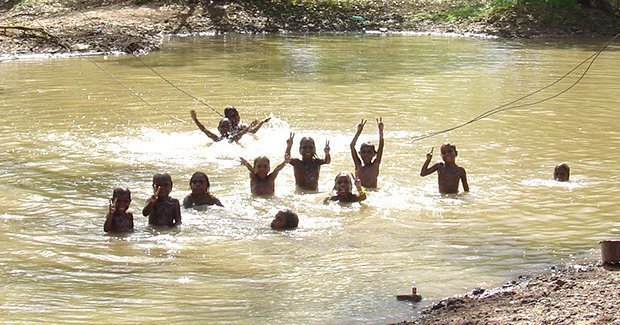New Aboriginal language born in the NT

LIGHT WARLPIRI IS A newly-evolved language spoken by about 300 people in the Lajamanu Aboriginal community, located at the edge of the Tanami Desert, about 890km south of Darwin.
The language combines elements of English, Kriol (an English-based creole that emerged in the late nineteenth-century) and Warlpiri, an endangered traditional language that is spoken in central Australia by about 4000 people.
Australian linguist Dr Carmel O’Shannessy, who speaks Warlpiri, discovered the existence of Light Warlpiri while working as a teacher and linguist at Lajamanu in the late 1990s.
Linguistic creativity
In a paper published this month in the journal Language, Carmel documents for the first time the grammatical structure of the language and discusses the social context that led to its emergence.
“The linguistic creativity shown by the innovators of Light Warlpiri is wonderful,” Carmel told Australian Geographic. The language began to emerge among children in the late 1970s. It is now spoken by adults aged up to about 35 years and is the first language of many children in the Lajamanu community.
“During my four years living and working in the community, I realised that when children spoke to each other, every sentence contained both Warlpiri and English/Kriol,” says Carmel, who is now based at the University of Michigan, in the USA.
She recorded children speaking and discovered that their language, Light Warlpiri, was structured in an entirely new way.
Indigenous languages of Australia
“When I transcribed their speech, and looked for patterns across sentences, I was struck by how systematic it was,” Carmel says. In Light Warlpiri, most verbs come from either English or Kriol and most nouns have Warlpiri suffixes attached to them, however sentences are strung together using a “radically innovative” structure.
“This was fascinating,” Carmel says. “I realised that it was indeed a language system, independent of those other languages.”
With the help of the Lajamanu community, Carmel hopes to continue tracking the evolution of Light Warlpiri. “To be able to observe a new language as it unfolds is very exciting,” she says, adding that children are very important in this process. “Children can be active agents of language change, and dramatic change can take place very rapidly.”

Carmel (back, left) with Gracie White Napaljarri, a Warlpiri speaker, and children in her extended family, who are Light Warlpiri speakers. (Credit: Carmel O’Shannessy)
Evolution of Aboriginal speech
Professor Nicholas Evans, head of linguistics at the Australian National University (ANU) in Canberra, says Light Warlpiri is one of only a handful of documented examples of such “language intertwining”, where new languages have evolved by combining the core grammatical elements of others.
“This work is tremendously significant in reminding us that traditional cultures and languages are dynamic and constantly evolving,” he says, commenting how unusual it is to encounter “a new language that is emerging before our very eyes.”
Professor Jane Simpson, Chair of Indigenous linguistics at ANU agrees. “It is a rare opportunity to see the effects of a very rapid shift from one language to a new language; usually we only see the results long after the change has happened,” she says. “Carmel’s analysis of this mixed language has revolutionised the way we think about Australian Indigenous languages, and will revolutionise how we think about language evolution generally.”
RELATED STORIES

